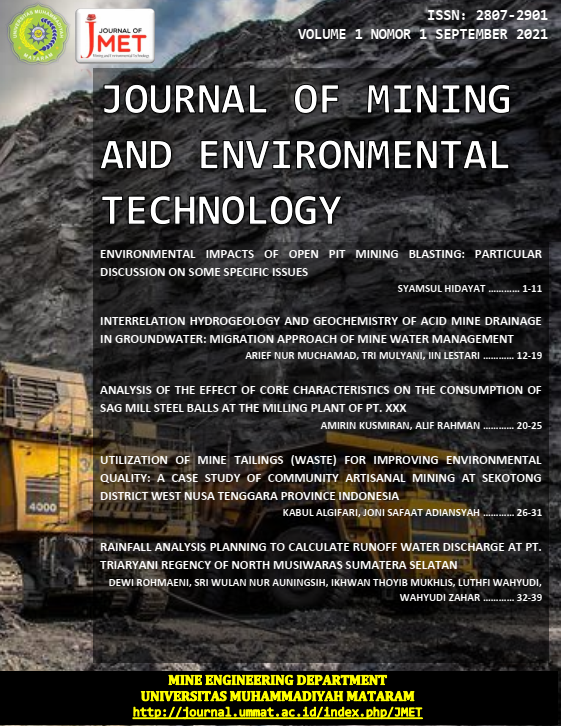Utilization of mine tailings (waste) for improving environmental quality: a case study of community artisanal mining at Sekotong District West Nusa Tenggara Province Indonesia
DOI:
https://doi.org/10.31764/jmet.v1i1.6005Keywords:
artisanal mining, paving block, tailing, compressive strength, SekotongAbstract
Tailing is one of the wastes that generated by mining activity and recorded around 14 billion tons worldwide. Artisanal mining is also producing tailing from its processing activity (‘Gelondong’ and ‘Tong’) and creates potential environmental impact associated with tailing management. One of the strategies to reduce the impact is by applying the tailing utilization strategy. This paper is aimed to assess the possibility of using tailing that generated by community artisanal mining activity for construction purposes (paving block). In order to achieve the aim, the laboratory analysis and case study are applied. Six paving blocks that consist of normal paving block, and 15% tailing paving block were prepared and tested its compressive strength. In addition, the tailing that used was generated by community artisanal mining at Sekotong District of West Nusa Tenggara Province. The result showed that the increasing compressive strength of normal paving block from day 14 to day 28 (ultimate) was 26% higher compared to tailing paving block. However, based on the SNI standard that these two types of paving block are categorized as quality B of paving block and could be used as parking pavement construction. Therefore, the 15% tailing paving block met with the SNI standard.References
Adiansyah, J.S., 2018. Kajian Dampak Sosial Ekonomi Kegiatan Pertambangan Rakyat di Kecamatan Sekotong Kabupaten Lombok Barat. Gerung.
Adiansyah, J.S., Rahmawati, D., 2019. Estimating the escalation of mine tailings disaster risks by using a life cycle assessment approach. In: IOP Conference Series: Materials Science and Engineering.
Antono, 1995. Civil construction material. Penerbit Universitas Atma Jaya, Yogyakarta.
IMM, 2008. The CeremextTM Procces. Idaho.
PTFI, 2006. Tailing Bukan Limbah - Tailing Adalah Sumber Daya – Tailing Dapat Menjadi Bahan Konstruksi. Mimika.
Rahmawati, D., Adiansyah, J.S., 2020. An overview of remediation technology for mercury-contaminated sediment in Sekotong Sub District, Lombok, Indonesia. In: IOP Conference Series: Earth and Environmental Science.
Riogilang, H., Halimah, M., 2009. Pemanfaatan Limbah Tambang Untuk Bahan Konstruksi Bangunan. Ekoton 9, 69–73.
SNI, 1996. Paving block: SNI 03-0691-1996.
Song, X., Pettersen, J.B., Pedersen, K.B., Røberg, S., 2017. Comparative life cycle assessment of tailings management and energy scenarios for a copper ore mine: A case study in Northern Norway. J. Clean. Prod. 164, 892–904.
Syarifuddin, 2018. Creating and testing the batako compressive strenght by adding waste. JFT J. Fis. dan Terap. 5.
Wels, C., Robertson, A.M., 2003. Conceptual model for estimating water recovery in tailings impoundments. Tailings Mine Waste 87–94.
Yilmaz, E., Fall, M., 2017. Introduction to paste tailings management. In: Paste Tailings Management. pp. 1–5.

